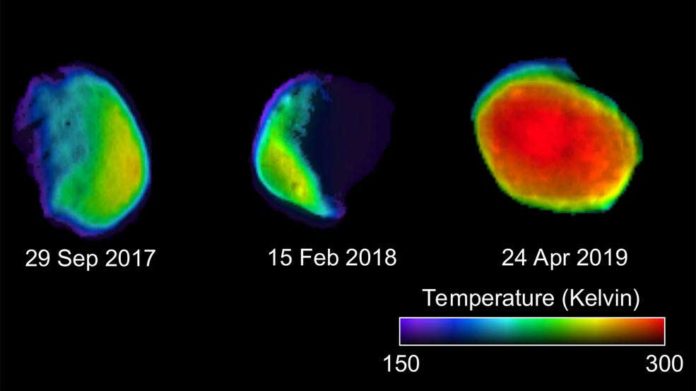NASA’s Mars Odyssey orbiter, for the first time, has captured the Martian moon Phobos during a full moon phase. The image is a kind of temperature bullseye represented with different colors looks like a rainbow-colored jawbreaker.
Odyssey’s heat-vision camera, the Thermal Emission Imaging System (THEMIS) is capable of detecting variation in surface temperature as Phobos circles Mars every seven hours. Each Phobos observation is done from a slightly different angle or time of day, providing a new kind of data.
On April 24, 2019, THEMIS looked at Phobos dead-on, with the Sun behind the spacecraft. This full moon view is better for studying material composition, whereas half-moon views are better for looking at surface textures.
Joshua Bandfield, a THEMIS co-investigator and senior research scientist at the Space Sciences Institute in Boulder, Colorado said, “With the half-moon views, we could see how rough or smooth the surface is and how it’s layered. Now we’re gathering data on what minerals are in it, including metals.”
“Iron and nickel are two such metals. Depending on how abundant the metals are, and how they’re mixed with other minerals, these data could help determine whether Phobos is a captured asteroid or a pile of Mars fragments, blasted into space by a giant impact long ago.”

“These recent observations won’t definitively explain Phobos’ origin. But Odyssey is collecting vital data on moon scientists still know little about — one that future missions might want to visit. Human exploration of Phobos has been discussed in the space community as a distant, future possibility, and a Japanese sample-return mission to the moon is scheduled for launch in the 2020s.”
“By studying the surface features, we’re learning where the rockiest spots on Phobos are and where the fine, fluffy dust is. Identifying landing hazards and understanding the space environment could help future missions to land on the surface.”
“I think it’s a great example of taking a spacecraft that’s been around a very long time and finding new things you can do with it. It’s great that you can still use this tool to collect groundbreaking science.”
